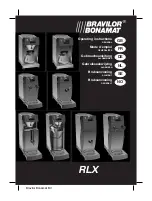
MIG WELDING FAULTS
7 EN
EN
In general the applicable current range for wire use is:
- Ø wire mm x 100 = minimum Amps.
- Ø wire mm x 200 = minimum Amps.
Example: Ø filo 1.2 mm= minimum Amps 120 mm/maximum
Amps 240. The above range is used with binary AR/CO2 gas
mixtures and with short-circuiting transfer (SHORT).
3.
Do not weld parts where rust, oil or grease is present.
4.
Use a torch suited to welding current specifications.
5.
Periodically check that the earth clamp pads are not dam-
aged and that the welding cables (torch and earth) are not cut
or burnt which could impair efficiency.
7.3
STAINLESS STEEL WELDING
MIG Welding of 300 series (austenitic) stainless steel must be car-
ried out with a shielding gas that has a high Argon content and a
small percentage of O2 to stabilise the arc. The most commonly
used mixture is AR/O2 98/2.
- Never use CO2 or AR/CO2 mixtures.
- Never touch the wire.
The filler material used must be of a higher quality than the base
material and the welding zone must be completely clean.
7.4
ALUMINIUM WELDING
To MIG weld aluminium, use the following:
1.
100% Argon shielding gas.
2.
Filler wire with a composition suited to the base welding ma-
terial. To weld ALUMAN and ANTICORODAL use 3-5% sili-
con wire.To weld PERALUMAN and ERGAL use 5%
magnesium wire.
3.
Use a torch designed for aluminium welding.
7.5
SPOT WELDING
This type of welding is used for spot welding two overlapping
sheets, and requires the use of a special gas nozzle.
Fit the spot welding gas nozzle, press it against the piece to be
welded. Press the torch button; note that the welder will eventually
detach from the piece. This time period is fixed by the TIMER con-
trol (Ref. 5 - Picture 1 Page 5., - Picture 5 Page 6.), and must be
set depending on the thickness of the material.
8.0
MIG WELDING FAULTS
FAULT CLASSIFICATION AND DESCRIPTION
MIG welds may be affected by various defects, which are impor-
tant to identify. These faults do not differ in form or nature from
those encountered during manual arc welding with coated elec-
trodes. The difference between the two applications lies rather in
the frequency of defects: porosity, for example, is more common
in MIG welding, while inclusion of slag is only encountered in
welding with coated electrodes.
The causes and prevention of faults are also quite different. The
following table illustrates the various faults.
FAULT
APPEARANCE
CAUSE AND REMEDY
UNEVEN LEVEL
- Poor preparation.
- Align edges and hold during spot welding.
EXCESS THICKNESS
- No-load voltage or welding speed too low.
- Incorrect torch inclination.
- Wire diameter too large.
INSUFFICIENT METAL
- Welding speed too high.
- Welding voltage too low for welding application.
OXIDISED BEAD
- Weld in the channel if using a long arc.
- Regulate voltage.
- Wire is bent or over-protruding from the wire guide tube.
- Incorrect wire feed speed.
INSUFFICIENT PENETRATION
- Incorrect torch inclination.
- Irregular or insufficient distance.
- Wire guide tube worn.
- Wire speed too slow for voltage used or for welding speed.
OVER PENETRATION
- Wire speed too high.
- Incorrect torch inclination.
- Excessive distance.
LACK OF FUSION
- Distance too short.
- Rough out or grind the weld, then repeat.
CHANNELS
- Welding speed too high.
(This fault is easily detected on sight by the welder, and should be correct-
ed immediately.)









































